Rolling and Rolling-Sliding Contact Fatigue Failure Mechanisms in 32 CrMoV 13 Nitrided Steel—An Experimental Study
Abstract
:1. Introduction
2. Materials and Methods
3. Results and Discussion
3.1. Mechanical Characterisation of Nitrided Surface Layers
3.2. Failure Mechanisms in RCF Tests
3.3. Failure Mechanisms in RSCF
4. Conclusions
Author Contributions
Funding
Institutional Review Board Statement
Informed Consent Statement
Acknowledgments
Conflicts of Interest
References
- Cheng, W.; Cheng, H.S.; Keer, L.M. Longitudinal Crack Initiation under Pure Rolling Contact Fatigue. Tribol. Trans. 1994, 37, 51–58. [Google Scholar] [CrossRef]
- Chabert, G. Les différentes modes de détérioration des engrenages. Ingénieurs de l’Automobile 1971, 11, 627–633. [Google Scholar]
- Kaneta, M. Mechanism of crack growth in lubricated rolling-sliding contact. ASLE Trans. 1985, 28, 407–414. [Google Scholar] [CrossRef]
- Kaneta, M. Effect of oil hydraulic pressure on surface crack growth in rolling-sliding contact. Tribol. Int. 1987, 20, 210–217. [Google Scholar] [CrossRef]
- Murakami, Y. Analysis of surface crack propagation in lubricated rolling contact. ASLE Trans. 1985, 28, 60–68. [Google Scholar] [CrossRef]
- Murakami, Y. Crack initiation and propagation under lubricated rolling-sliding contact loading. In Proceedings of the Fourth International Conference on Biaxial/Multiaxial Fatigue, St. Germain en Laye, France, 31 May–3 June 1994; Sakae, C., Ed.; pp. 559–572. [Google Scholar]
- Fernández-Valdés, D.; Meneses-Amador, A.; Rodríguez-Castro, G.A.; Arzate-Vázquez, I.; Campos-Silva, I.; Nava-Sánchez, J.L. Standing contact fatigue behavior of nitrided AISI 316L steels. Surf. Coat. Technol. 2019, 377, 124871. [Google Scholar] [CrossRef]
- Escobar-Hernández, J.; Rodríguez-Castro, G.A.; Arzate-Vázquez, I.; Meneses-Amador, A.; Morón, R.C. Fatigue damage assessment from cyclic spherical contact of borided and nitrided H13 steel. Mater. Lett. 2021, 285, 129118. [Google Scholar] [CrossRef]
- Wang, G.; Qu, S.; Lai, F.; Li, X.; Fu, Z.; Yue, W. Rolling contact fatigue and wear properties of 0.1C-3Cr-2W-V nitrided steel. Int. J. Fatigue 2015, 77, 105–114. [Google Scholar] [CrossRef]
- Tallian, T.E. Failure Atlas for Hertz Contact Machine Elements; American Society of Mechanical Engineers: New York, NY, USA, 1992. [Google Scholar]
- Cheng, W.; Cheng, H.S.; Keer, L.M. Experimental Investigation on Rolling/Sliding Contact Fatigue Crack Initiation with Artificial Defects. Tribol. Trans. 1994, 37, 1–12. [Google Scholar] [CrossRef]
- Kloos, K.H.; Schmidt, F. Surface Fatigue Wear—Causes and and remedial measures. Metall. Asp. Wear 1981, 163–181. [Google Scholar]
- Fujita, K. Surface fatigue failure of nitrided-hardened aluminium-chromium-molybdenum steel rollers under pure rolling and sliding-rolling contacts. Wear 1979, 53, 61–68. [Google Scholar] [CrossRef]
- Fujita, K.; Yoshida, A. Surface Failure of Soft and Surface-Hardened Steel Rollers in Rolling Contact. Wear 1979, 55, 27–39. [Google Scholar] [CrossRef]
- Devi, M.U. Plasma-nitriding of tool steels for combined percussive impact and rolling fatigue wear applications. Surf. Coat. Technol. 1998, 107, 55–64. [Google Scholar] [CrossRef]
- Gawronski, Z. Aspects of trobological surface design with particular reference to the effects of low pressure nitriding and residual stresses in rolling contacts. Surf. Coat. Technol. 2001, 141, 62–69. [Google Scholar] [CrossRef]
- Stewart, S.; Ahmed, R. Rolling contact fatigue of surface coatings—A review. Wear 2002, 253, 1132–1144. [Google Scholar] [CrossRef] [Green Version]
- Boniardi, M.; D’Errico, F.; Tagliabue, C. Influence of carburizing and nitriding on failure of gears—A case study. Eng. Fail. Anal. 2006, 13, 312–339. Available online: http://www.sciencedirect.com/science/article/pii/S1350630705001470 (accessed on 30 October 2013). [CrossRef]
- Borghi, A.; Gualtieri, E.; Marchetto, D.; Moretti, L.; Valeri, S. Tribological effects of surface texturing on nitriding steel for high-performance engine applications. Wear 2008, 265, 1046–1051. Available online: http://www.sciencedirect.com/science/article/pii/S0043164808000914 (accessed on 30 October 2013). [CrossRef]
- Cerny, I.; Mikulova, D.; Furbacher, I. Fatigue Strength and Failure Mechanisms of Nitrided Small Parts of a 30CrMoV9 Steel. Mater. Manuf. Process. 2011, 26, 1–6. [Google Scholar] [CrossRef]
- Pichard, I.; Girodin, D.; Dudragne, G.; Moraux, J.Y. Metallurgical and Tribological Evaluation of 32 CrMoV 13 Nitrided Steel and XD15NTM High Nitrogen Martensitic Stainless Steel for Aerospace Applications; ASTM International: Conshohocken, PA, USA, 1997; Volume 1327. [Google Scholar]
- Girodin, D. Deep Nitrided 32CrMoV13 Steel for Aerospace Bearings Applications. NTN Tech. Rev. 2008, 76, 24–31. [Google Scholar]
- Barralis, J.; Chaize, J.C. Caractérisation des Couches Nitrurés pour Engrenages en 32CDV13 en Vue d’une Amelioration de leur Comportement en Service. Trait. Therm. 1985, 197, 59–65. [Google Scholar]
- Barrallier, L. Etude métallurgique de la nitruration de l’acier de nuance 32 CDV 13. Int. Fr. du Trait. Therm. 1991. [Google Scholar]
- Chala, A.; Chekour, L.; Nouveau, C.; Saied, C.; Aida, M.S.; Djouadi, M.A. Study of the duplex treatment on 32CrMoV13 low alloy steel: Application in wood machining. Surf. Coatings Technol. 2005, 200, 512–516. Available online: http://www.sciencedirect.com/science/article/pii/S0257897205003117 (accessed on 30 October 2013). [CrossRef]
- Chekour, L.; Nouveau, C.; Chala, A.; Djouadi, M.A. Duplex treatment of 32CrMoV13 steel by ionic nitriding and triode sputtering: Application to wood machining. Wear 2003, 255, 1438–1443. [Google Scholar] [CrossRef]
- Coelho, L.; Dias, A.; Lieurade, H.P.; Maitournam, H. Experimental and numerical rolling contact fatigue study on the 32CrMoV13 steel. Fatigue Fract. Eng. Mater. Struct. 2004, 27, 811–823. [Google Scholar] [CrossRef] [Green Version]
- Vergne, P.; Flamand, L. La lubrification Elastohydrodynamique—État Actuel des Recherches. In La Lubrification des Engrenages—Recueil de Conférences; CETIM: Paris, France, 1995; pp. 1–23. [Google Scholar]
- Hamrock, B.J.; Dowson, D. Isothermal Elastohydrodynamic Lubrication of Point Contacts: Part III—Fully flooded results. ASME J. Lubr. Technol. 1977, 99, 264–276. [Google Scholar] [CrossRef]
- Dowson, D. Elastohydrodynamic and Micro-Elastohydrodynamic Lubrication. Wear 1995, 190, 125–138. [Google Scholar] [CrossRef]
- Macherauch, E.; Müller, P. Das sin2y-Verfahren der Röntgenographischen Spannungsmessung. Z. Angew. Phys. 1961, 13, 305–312. [Google Scholar]
- Le, M.; Ville, F.; Kleber, X.; Buffière, J.-Y.; Cavoret, J.; Sainte-Catherine, M.-C.; Briancon, L. Rolling contact fatigue crack propagation in nitrided alloyed steels. Proc. Inst. Mech. Eng. Part J J. Eng. Tribol. 2017, 231, 1192–1208. [Google Scholar] [CrossRef]
- Coules, H.E.; Horne, G.C.M.; Kabra, S.; Colegrove, P.; Smith, D.J. Three-dimensional mapping of the residual stress field in a locally-rolled aluminium alloy specimen. J. Manuf. Process. 2017, 26, 240–251. [Google Scholar] [CrossRef]
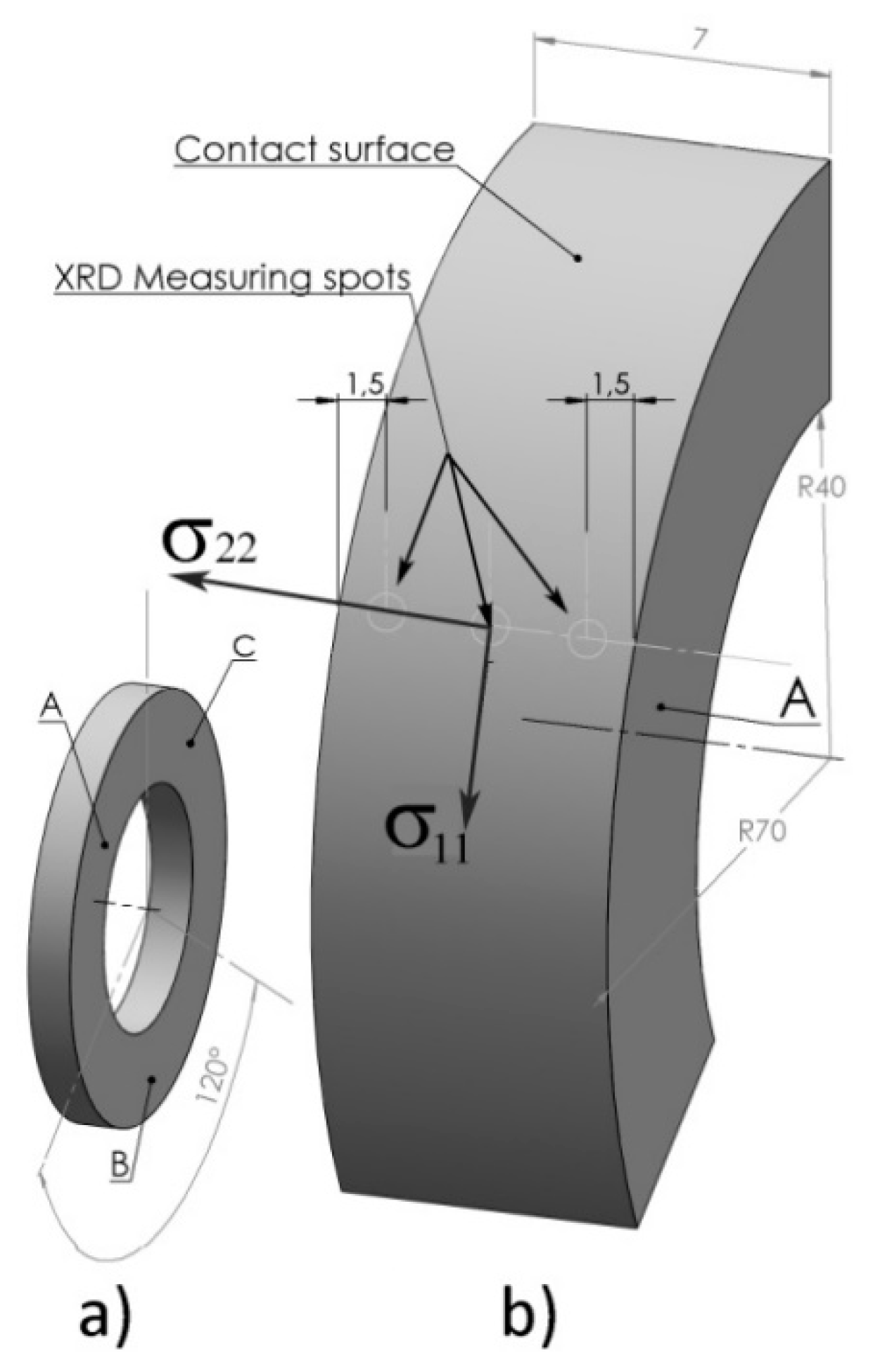
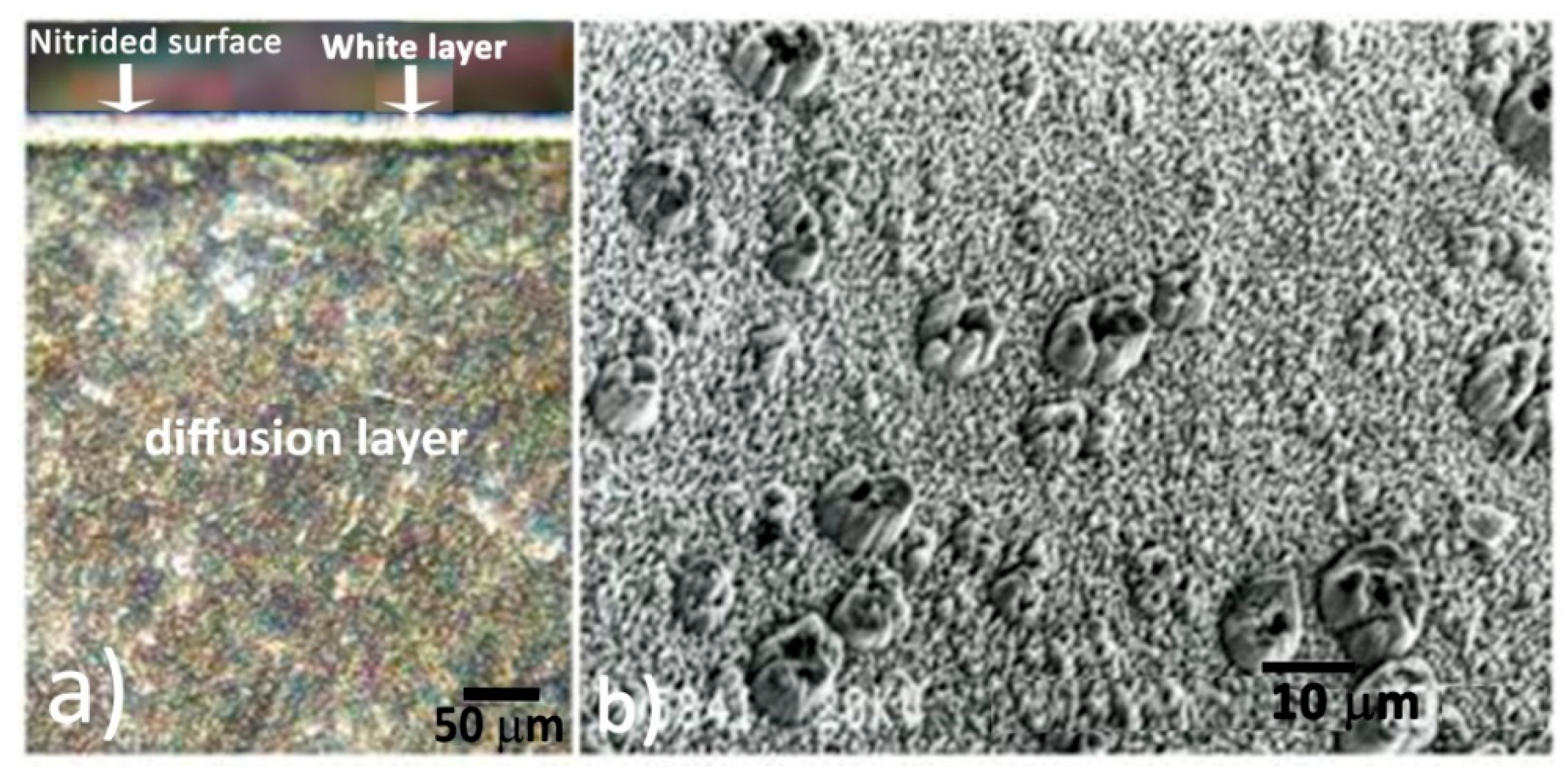
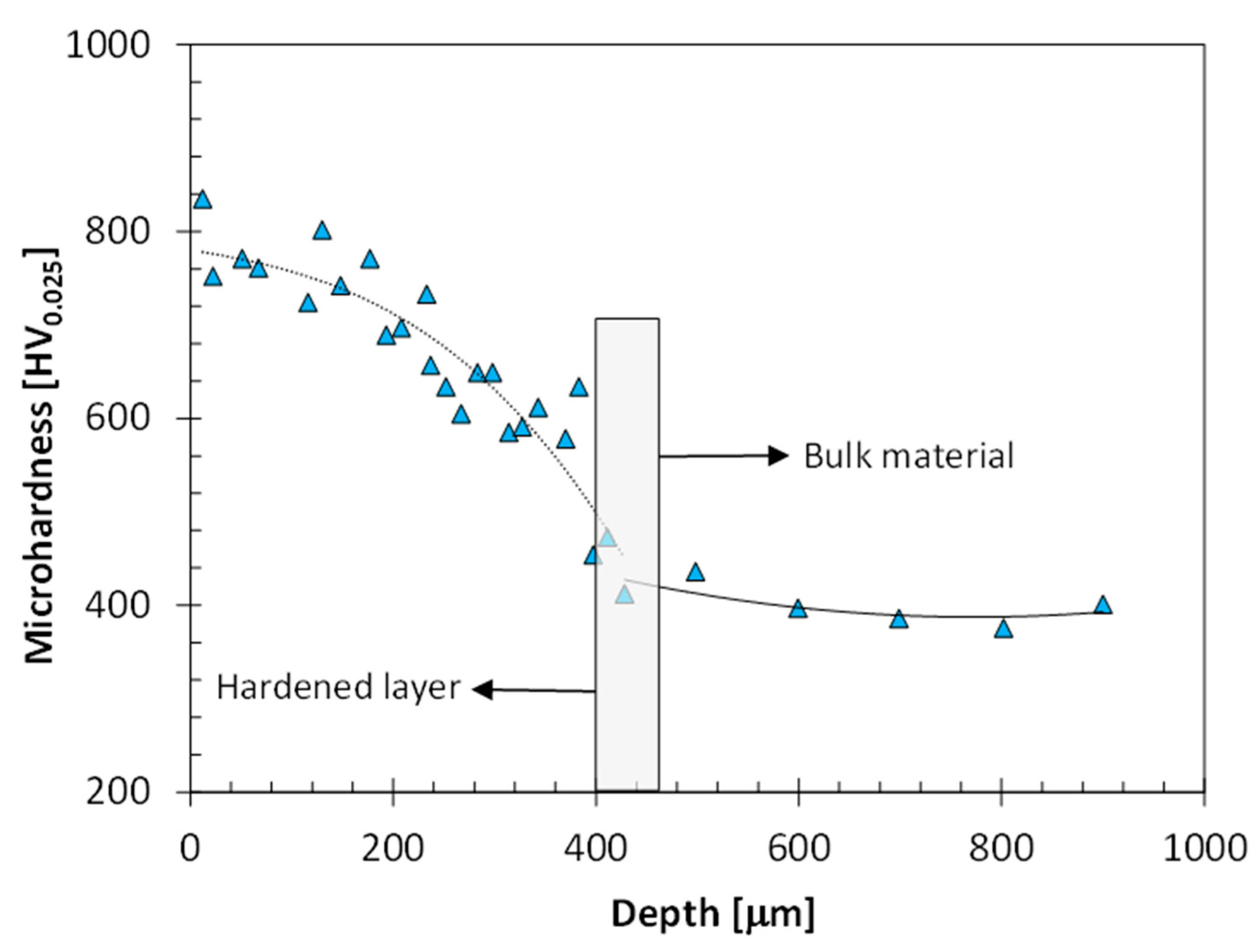
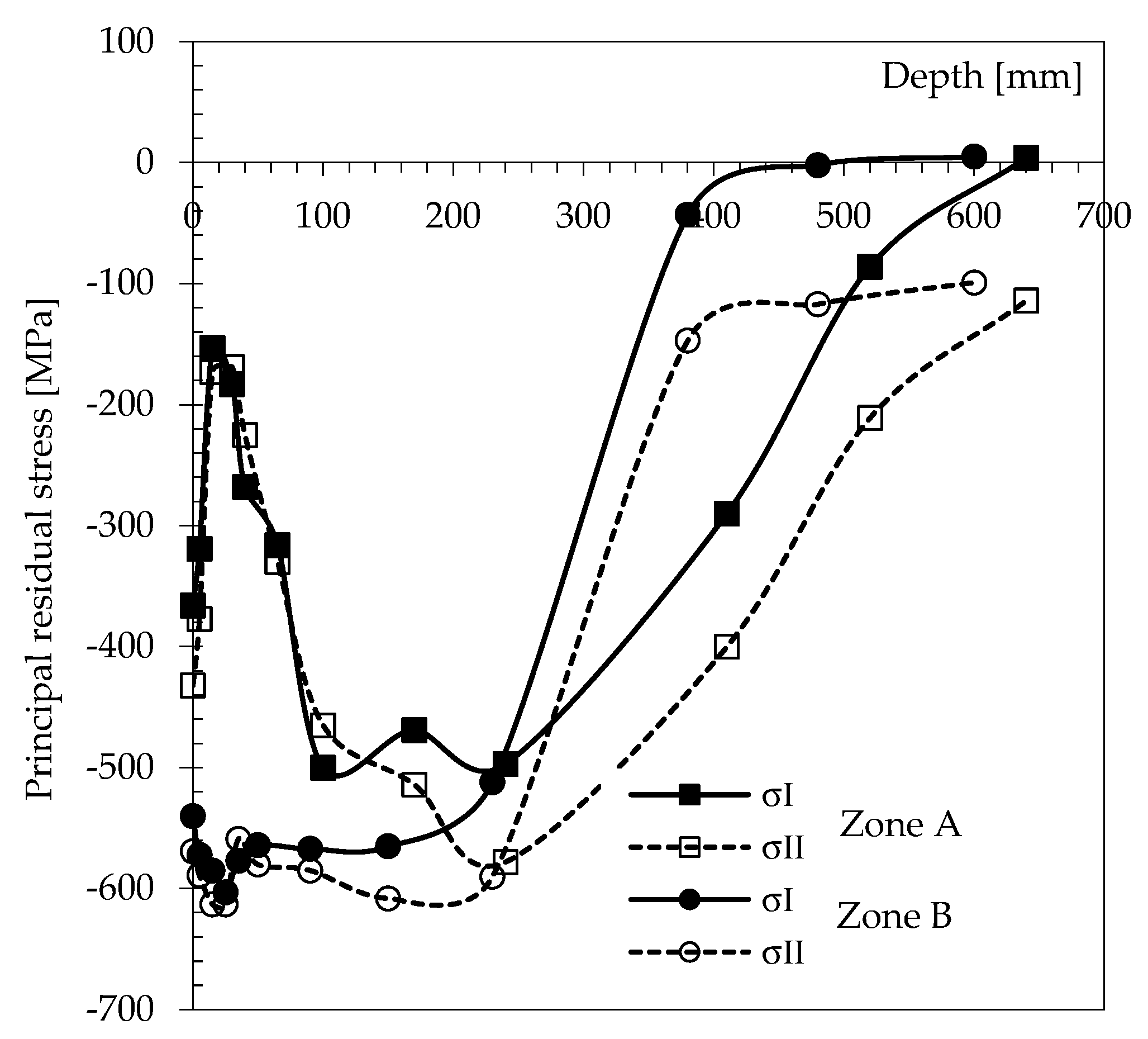
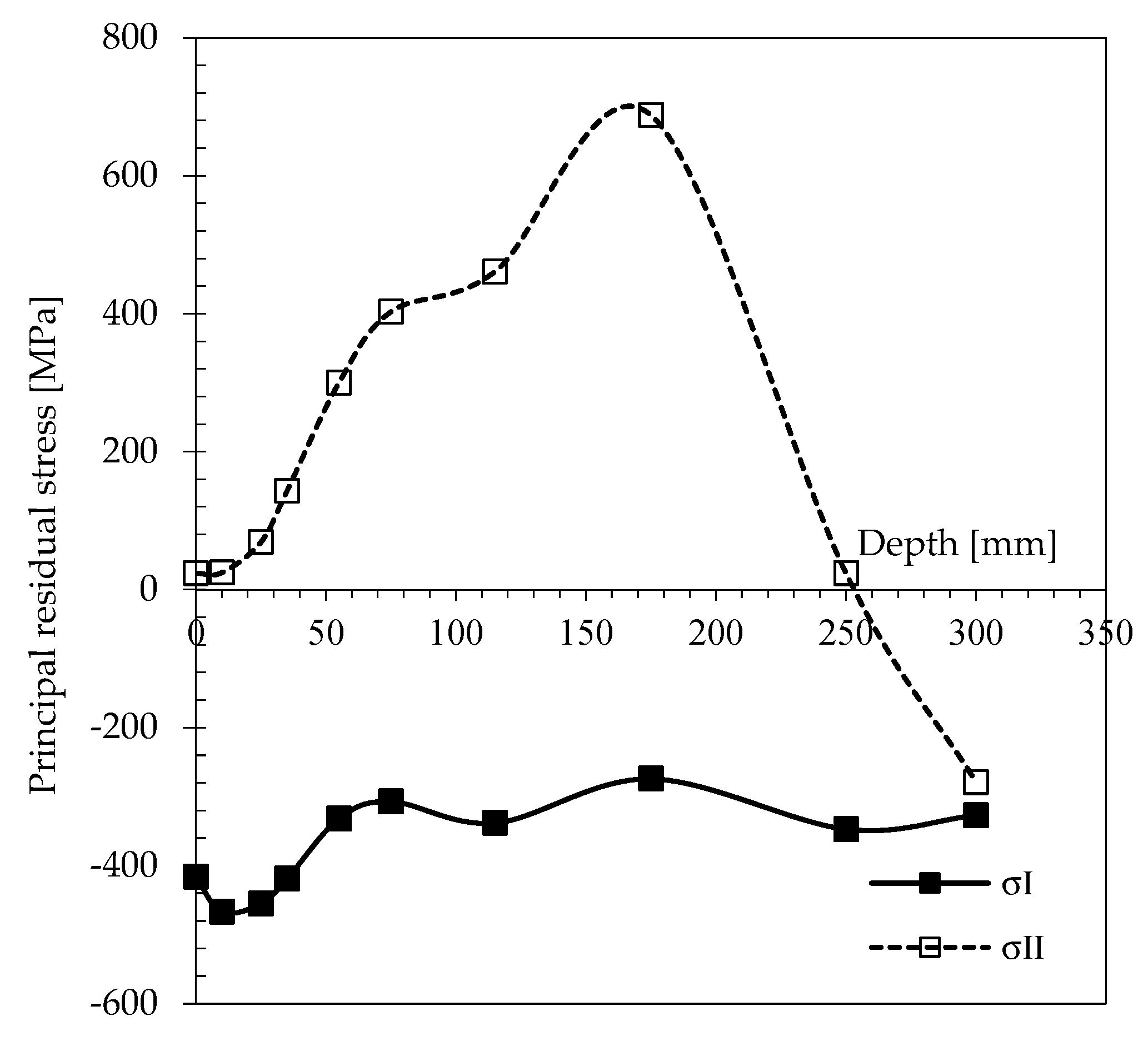
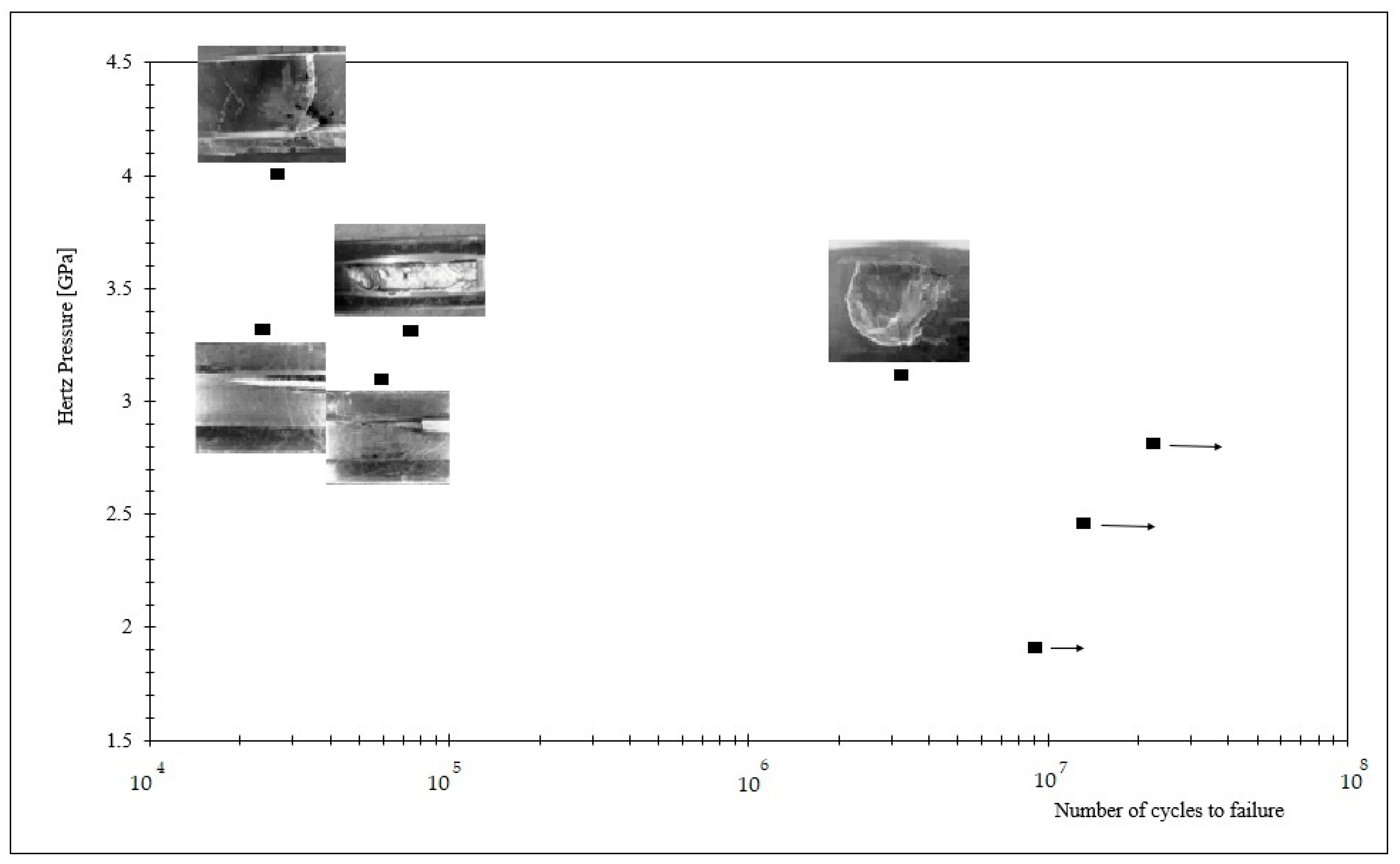
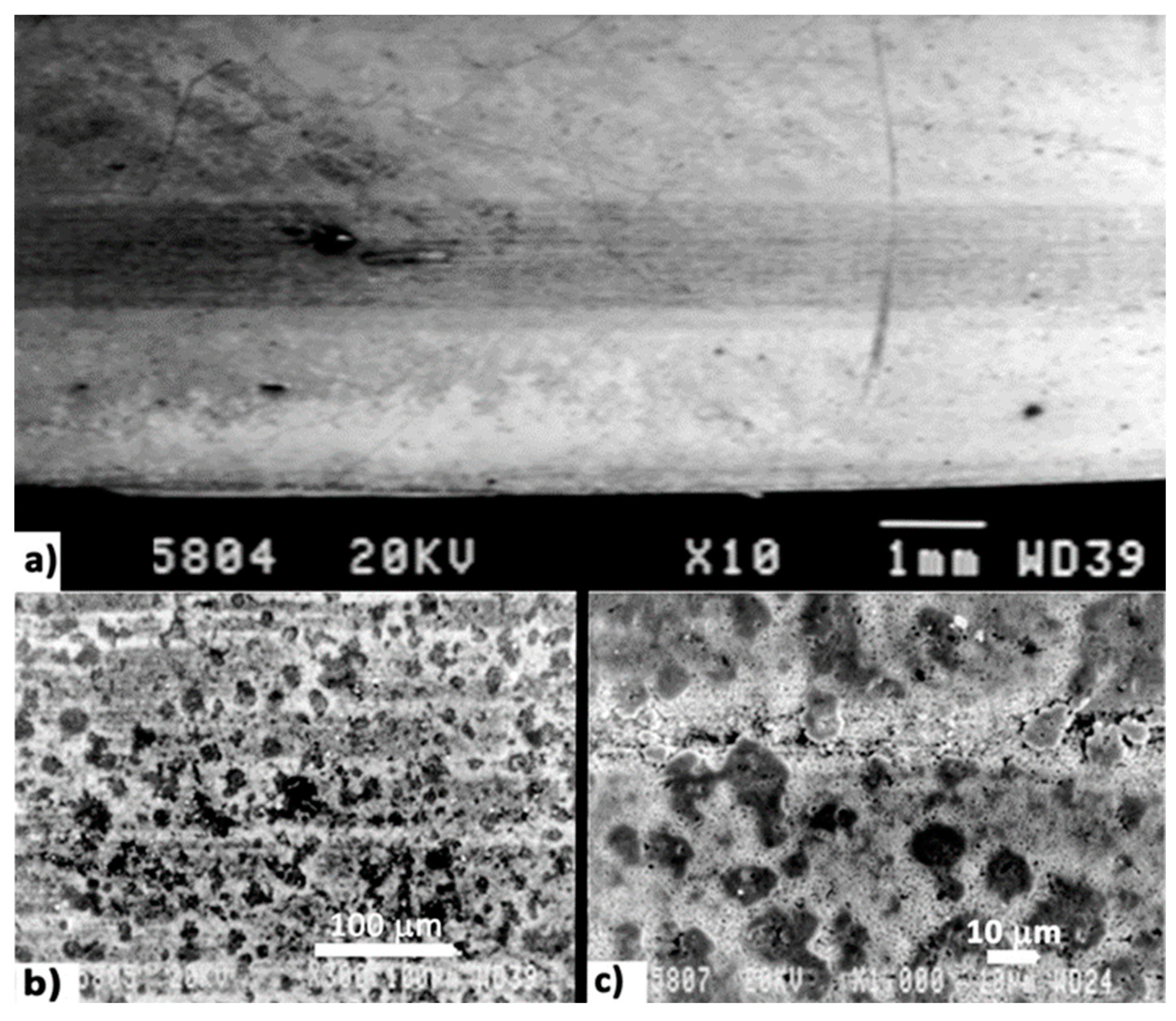
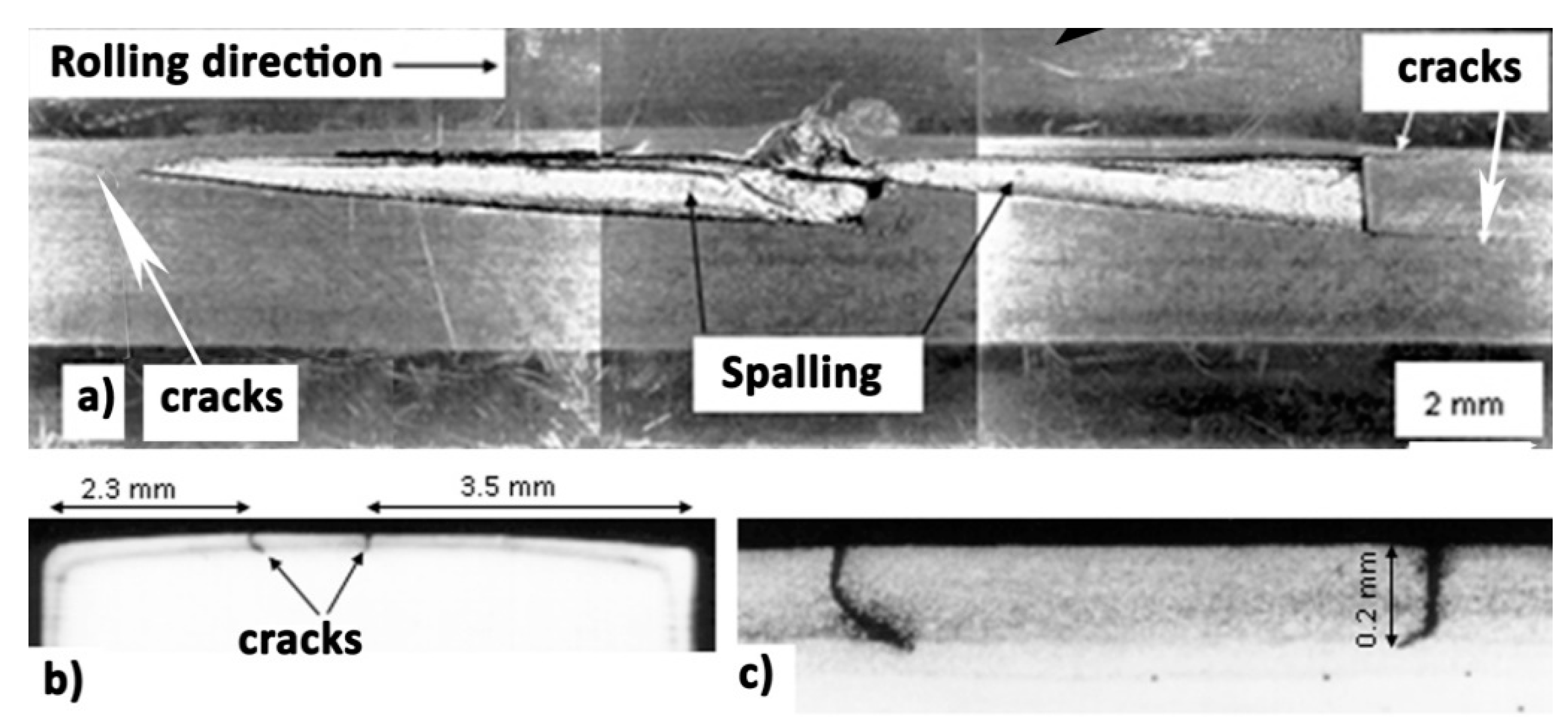
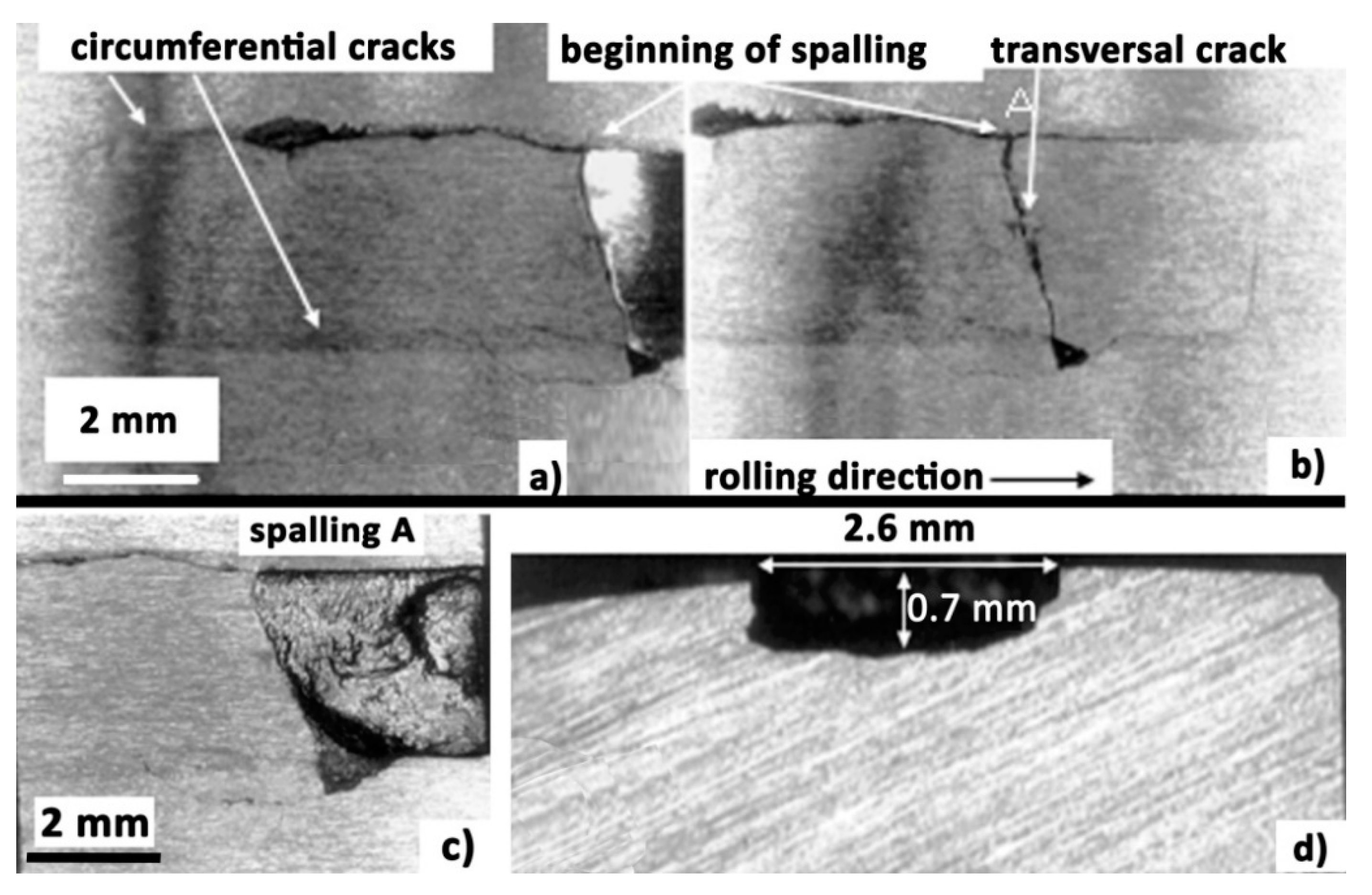
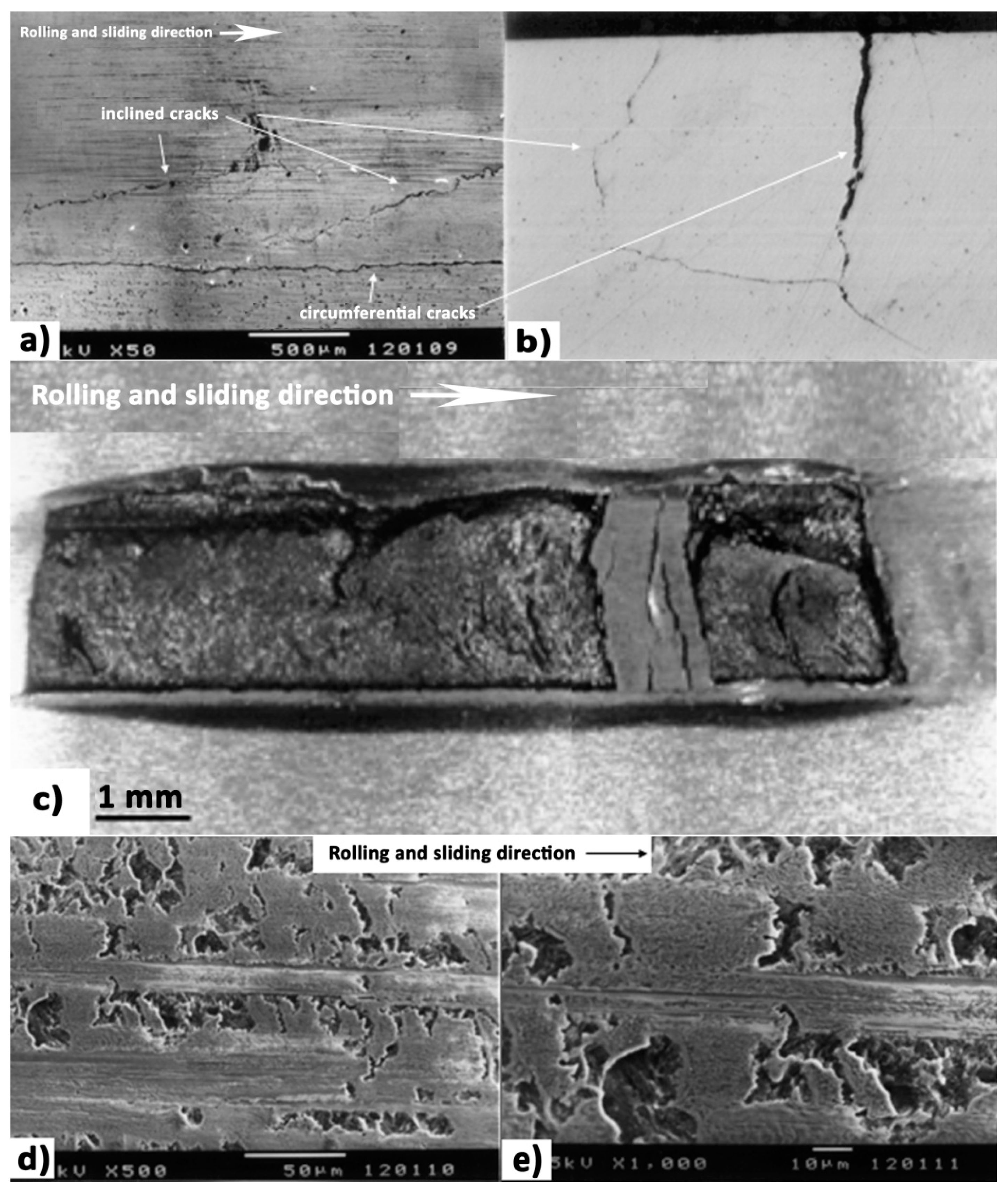
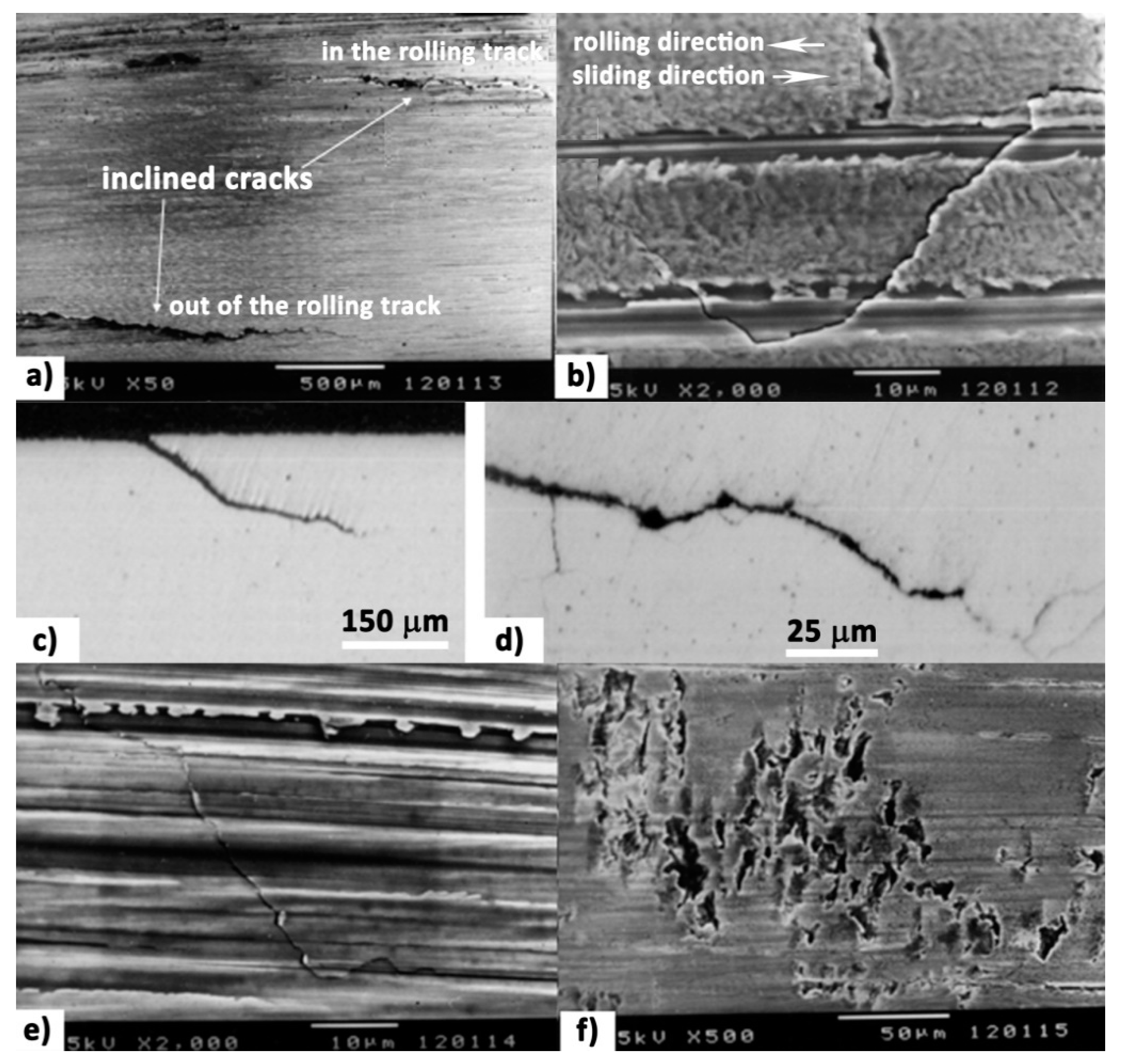

| Load [N] | Hertz Pressure, PH [GPa] | Contact Area [mm] | Minimum Film Thickness, h [µm] | Roughness, Ra [µm] | Lambda Ratio Λ | Sliding Rate, λ [%] |
|---|---|---|---|---|---|---|
| 960 | 1.9 | 0.467 × 0.511 | 0.403 | 0.72 | 0.407 | 0 |
| 3660 | 3.0 | 0.730 × 0.798 | 0.277 | 0.2 | 0.979 | 6.4 |
| 4000 | 3.1 | 0.752 × 0.822 | 0.363 | 0.7 | 0.367 | 0 |
| 5000 | 3.3 | 0.810 × 0.886 | 0.358 | 0.2 | 1.266 | 0 |
| 0.358 | 0.7 | 0.362 | 0 | |||
| 0.271 | 0.2 | 0.958 | 6.4 | |||
| 7000 | 3.7 | 0.906 × 0.991 | 0.349 | 0.2 | 1.234 | 0 |
| 0.265 | 0.937 | 6.4 |
| Values in [MPa] | Zone A | Zone B | Zone C | ||||
|---|---|---|---|---|---|---|---|
| Before RCF | After RCF | Before RCF | After RCF | Before RCF | After RCF | ||
| Specimen B | σ11 | −386 ± 61 | −543 ± 12 | −387 ± 19 | |||
| σ12 | −430 ± 62 | −565 ± 13 | −391 ± 20 | ||||
| Specimen A | σ11 | −510 ± 23 | −465 ± 21 | −540 ± 21 | −414 ± 21 | −495 ± 20 | −417 ± 23 |
| σ12 | −513 ± 24 | −176 ± 24 | −572 ± 21 | +21 ± 24 | −450 ± 20 | −58 ± 23 | |
| Contact Surface | Point 1 | Central Point | Point 2 | |
|---|---|---|---|---|
| Specimen A | σ11 | −502 ± 26 | −540 ± 21 | −502 ± 22 |
| σ12 | −484 ± 28 | −572 ± 21 | −416 ± 23 |
Publisher’s Note: MDPI stays neutral with regard to jurisdictional claims in published maps and institutional affiliations. |
© 2021 by the authors. Licensee MDPI, Basel, Switzerland. This article is an open access article distributed under the terms and conditions of the Creative Commons Attribution (CC BY) license (https://creativecommons.org/licenses/by/4.0/).
Share and Cite
Coelho, L.; Batista, A.C.; Nobre, J.P.; Marques, M.J. Rolling and Rolling-Sliding Contact Fatigue Failure Mechanisms in 32 CrMoV 13 Nitrided Steel—An Experimental Study. Appl. Sci. 2021, 11, 10499. https://doi.org/10.3390/app112110499
Coelho L, Batista AC, Nobre JP, Marques MJ. Rolling and Rolling-Sliding Contact Fatigue Failure Mechanisms in 32 CrMoV 13 Nitrided Steel—An Experimental Study. Applied Sciences. 2021; 11(21):10499. https://doi.org/10.3390/app112110499
Chicago/Turabian StyleCoelho, Luís, António C. Batista, João Paulo Nobre, and Maria José Marques. 2021. "Rolling and Rolling-Sliding Contact Fatigue Failure Mechanisms in 32 CrMoV 13 Nitrided Steel—An Experimental Study" Applied Sciences 11, no. 21: 10499. https://doi.org/10.3390/app112110499
APA StyleCoelho, L., Batista, A. C., Nobre, J. P., & Marques, M. J. (2021). Rolling and Rolling-Sliding Contact Fatigue Failure Mechanisms in 32 CrMoV 13 Nitrided Steel—An Experimental Study. Applied Sciences, 11(21), 10499. https://doi.org/10.3390/app112110499









